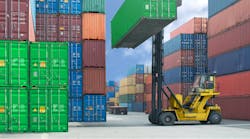Download this article in PDF format.
Even as companies around the globe continue to grapple with ongoing supply disruptions, some good news is coming out of the freight sector. Ocean containers are no longer stacking up outside of major ports for weeks on end, transportation costs are leveling off for most modes and it’s taking less time for cargo to get from factories in Asia to U.S. and European destinations (86 days now versus a peak of 113 days in January 2022).
One of the most positive indicators that supply chain delays may finally be easing came from Marine Exchange of Southern California, which reported that the backup of container ships has fallen from a peak of 109 vessels in January to just four ships in October. And with that, WSJ says that the backup of container ships off the state’s coast that created much of the supply chain congestion during the global pandemic has effectively disappeared.
“Shipping specialists say fewer ships than normal are heading to the main U.S. gateway complex for imports from Asia in coming days,” WSJ reports, “and that cargo volumes that had long swamped the ports now are receding.”
The backup started in October 2020, when five ships were queuing to unload at the Los Angeles-Long Beach complex. “The queue swelled to dozens of ships,” according to WSJ, “and shipping containers spilled out from the overfilled ports as Americans stuck at home under Covid-19 restrictions ordered massive volumes of household goods, office equipment and electronics that spurred a 20% surge in imports in 2021.”
And while bottlenecks are still impacting other U.S. ports and inland freight hubs, the publication sees the end of the California seaport backups as a sign that broader supply chain issues that have been troubling retailers and manufacturers may finally be unwinding.
Normalcy May be on the Near Horizon
After managing a high level of chaos over the last two-and-a-half years, supply chain and procurement departments are beginning to see a glint of light at the end of the tunnel. In fact, Bloomberg is even hinting that a more “normal” business environment could emerge as early as 2023. Citing the latest Logistics Managers’ Index, the publication says there may be a return to “business as usual” at some point in the coming year.
“That’s not to say everything will soon be running smoothly across the global economy,” Bloomberg points out. “Companies still struggle with shortages of parts and workers. Fragile supply chains are heading into another holiday season vulnerable to shocks ranging from freakish weather and dockworker strikes to China’s Covid lockdowns and Russia’s war in Ukraine.”
Some of the positive signs include improved international transportation capacity, lower weekly traffic figures at U.S. ports, fewer backlogs for incoming shipments, shorter delivery times and lower producer prices. “Spot rates for shipping containers have plunged about 60% this year as carriers struggle with the opposite problem they faced a year ago — excess capacity,” Bloomberg points out.
“Like airlines that cancel half-booked flights, the carriers are reducing the number of individual voyages in a practice called ‘blank sailings’ — or cutting entire service loops altogether — to match their available space with demand,” it adds, noting that the falling rates are “soothing the sting” of the record-high freight prices of the past two years.
Ghost of Supply Chain Past
Consumer sentiment hasn’t necessarily caught up with some of the newer trends taking place on the supply chain, logistics and transportation front. According to Transport Topics, a new Deloitte survey found that many U.S. consumers are still “haunted by the ghost of supply chain past.” In fact, over half of them expect stockouts in electronics and accessories, and 40% expect they won’t be able to find their favorite toys on the shelves.
As a result, nearly 40% of consumers surveyed said they’re likely to shop earlier than they did last year. “Between the launch of Amazon Prime’s Early Access Prime Sale in early October and other major sales from Target and Walmart,” Transport Topics reports, “Deloitte estimates that nearly a quarter of holiday budgets will be spent in the month of October.”









